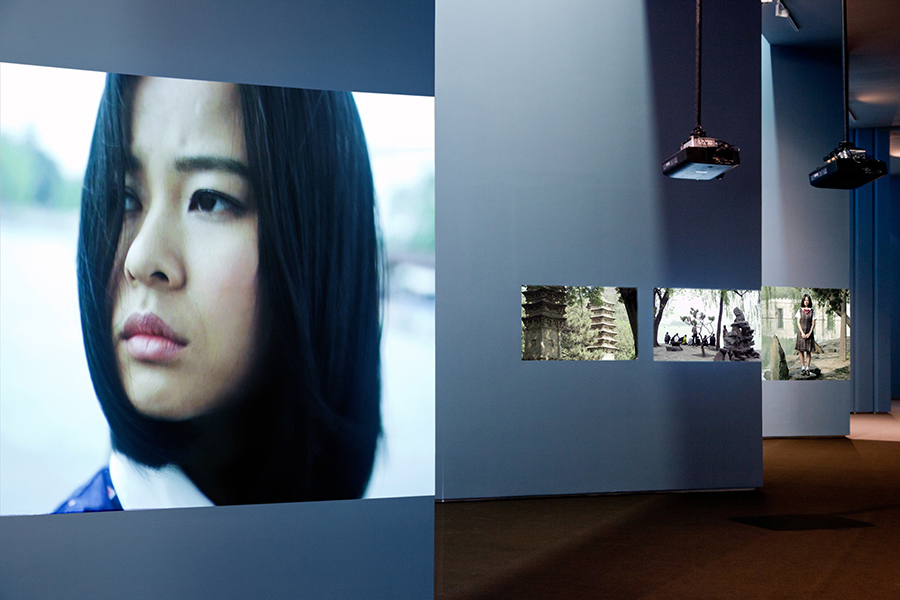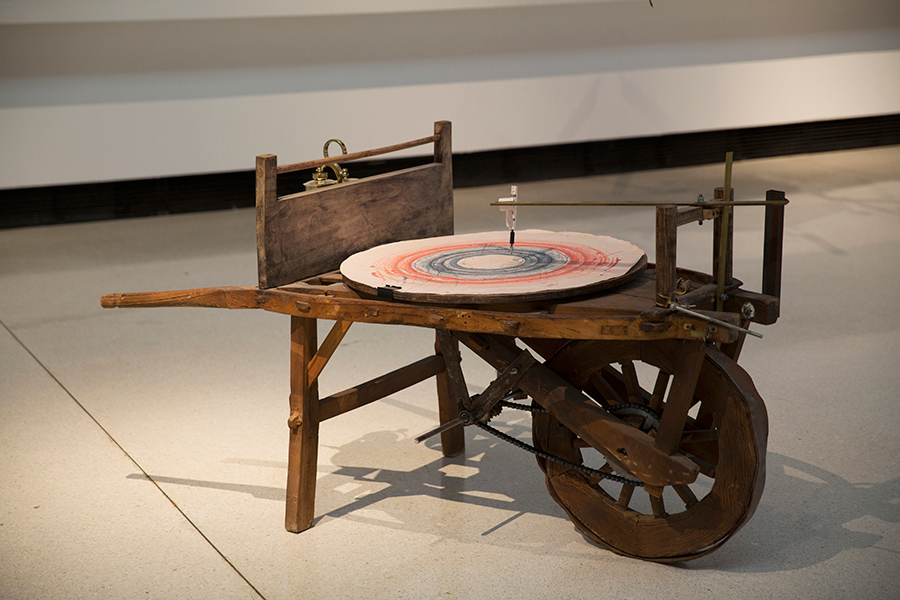
Tales from the Taiping Era
2014.05.23 - 2014.08.24
During the Taiping Era, Emperor Taizong of Song issued an imperial decree for scholars to compile books on art and literature, philosophy and the Confucian classics in a work entitled Imperial Readings of the Taiping Era. Meanwhile, historical anecdotes, biographies, supernatural tales and fiction were appended in an entirely separate work known as Tales from the Taiping Era. Since many scholars felt that the latter work held little practical value for future readers, Tales from the Taiping Era was tucked away and remained relatively unknown.
Tales from the Taiping Era is a collection of stories. The stories are gathered from scattered anecdotes and legends a full one hundred years before the Taiping Era (Western Yuan, December 976 to November 984). The era during which the work was compiled, therefore, not only included the Taiping Era of the Northern Song, but also included the Guangyun Period of the Northern Han, as well as the Mingzhen Period in Dali and the Zhongxing Period in Anding, the Bao Ding and Tianheng Periods in the Liao Kingdom as well as the Tianzung to the Zhongxing periods of the Yutian Kingdom. The Tales, therefore, were penned by unknown writers living in different historical periods. The editors of The Tales were by in large imperial scholars living subsequently in the Late Han, the Late Zhou, the Southern Tang and the Late Jin. But that’ s not the key issue. What is important, however, is that readers do not have to focus on the authenticity of the stories even though the when, where and who are all clearly designated in this work since events recorded in Tales from the Taiping Era were based on legends and unusual accounts, but delivered as if they were the words of wild men muttering in their sleep. As artist Wu Shanzhuan has said, all stories eventually come true – if it doesn’ t happen here, then it is bound to happen there.
Emperor Taizong of Song is not exactly the story-loving ruler you’ d expect to find in the pages of Borges. But he did have two major goals once he ascended the imperial throne. First, he wanted to unify all the kingdoms of China, an aspiration that wasnever fullfilled; second, he aimed to integrate the knowledge of the entire Chinese realm. To meet this latter goal, he ordered the compilation Foreword of a thousand volumes known as the Collected Works of the Taiping Era; along with a thousand volumes of fictional work entitled Tales from the Taiping Era; another thousand volumes of essays in a collective work called Essential Literary Classics; and a thousand volumes on medicinal remedies known as The Divine Classic of Medicinal Healing. Of all the compilations he had ordered by imperial edict, the compilation he paid most attention to was Collected Works from the Taiping Era. It is said that he read three volumes per day, working his way through all the compilations within the span of a single year. Gradually, Collected Works from the Taiping Era became known as the Imperial Readings of the Taiping Era. Collected Works was supplanted by the term Imperial Readings because in these writings, readers actually see the vicissitudes and revolutions of historical dynasties and take them as an informative guide to future developments. Although Tales from the Taiping Era shares the same name as Taiping, the work is actually comprised of“unofficial” knowledge on the vagaries of several historical dynasties – not just the Taiping.
Tales from the Taiping Era was initially comprised of fictional ccounts recorded from the Six Dynasties Period to the Early Song. This “strange classification” , to borrow the words of Qian Zhongshu, assembled bizarre tales from history, geography, literary sketches and Buddhist and Taoist classics. Disseminated via copies and prints, the performance quality of these folk narratives enjoyed a quiet following over the years, gradually gaining in popularity. After the Song, the period’ s vernacular folk stories, folk operas and plays were often adapted from stories found in Tales from the Taiping Era. Adrift on a sea of time, culled and collected from different historical periods, these mythical tales and magical figures thus make up various “contemporary stories” and ultimately constitute an unbroken continuum of fantasy taken straight out of the historical annals of Chinese life and society.
The title of the show, Tales from the Taiping Era, is intended to unleash the creative space-time continuum locked within the original stories. The intention focuses more on the extensive records of tales but rather the Taiping Era. While many artists today aim to show works that are simple and direct, participants in this show are deeply concerned about the increasingly shallow games enacted under the auspices of the exhibition system. Regardless of the media they work in, all of these artists are engaged in the possibilities of narrative and its underlying structures. In addition, both the young and well-established artists alike generally transcend the objects of“the works” themselves – intending to achieve a long-term and systematic accretion of extensions and mutations.
Tales from the Taiping Era is not the subject that the artists are responding to. But they do serve as a medium – a platinum thread in a chemical reaction, a catalyst in the creative process for both artists and writers. At the same time, the show invites viewers to enter an alternative space located within the continuous, longstanding tradition of Chinese folklore. As far as the artists are concerned, Tales from the Taiping Era not only serves as a viewing of the space – time continuum as well as a reading of the tales’ many diverse threads, it also works as a meaningful and confusing fantasy that demonstrates the true nature of space – time.
In emphasizing“narration” as curatorial method and creative strategy, the exhibition attempts to reignite the ancient narrative potential of art. Once again artists are called to play the role of observers, fortune-tellers and narrators; drawing on “unofficial knowledge”from past ages, and using“omens” to map out a social imagination and point to sensational foresights; conjoining“implications” to the present situation that lead to events and actions; and finally reclaiming gothic visions from the “history of alterity” to refract any opposition to potential reality. In addition, the long-lost power of omens, implications and gothic visions lies in everything that art has lost in the past one hundred years of modern experience.
To that end, we’ ve invited ten artists to participate in this exhibition, including Huang Yongping, Wu Shanzhuan and Inga Svala Thórsdóttir, Yung Ho Chang, Wang Jianwei, Chen Chieh-jen, Qiu Zhijie, Yang Fudong, Pak Sheung Chuen, Feng Bingyi, and Guo Xi. Taking Tales from the Taiping Era as a springboard, the artists have come up with a richly imaginative space and narrative structures; in the fractures and layers of contemporary reality and historical narrative, the artists also rename our social perceptions, everyday experiences and physical memories; the artists even reveal their long-term thinking and practices, as well as their different reflections on social imagination.
In the work of Huang Yongping, current events and chance encounters take on a fable-like existence, as ordinary, everyday reality gives way to cascading layers of phenomena and chains of interlocking metaphors. Wu Shanzhuan and Inga Svala Thórsdóttir inject the sphere of public power with a Promethean image. The fire-stealer/flame-thrower dual-motif infuses mythic constructs such as perspective/projection and reality / realness.
In his eccentric piece of theater called The Third Police Station, Yung Ho Chang repeatedly explores interactions between narrative space and architectural space. Wang Jianwei draws on his long-term thought patters on the imagery of time/events and dice throwing – compressing all his thoughts into an analysis engineering system oriented to inexplicable objects.
In the works of Chen Chieh-jen, images serve as a way of reactivating ideologies and reality, incessantly reviving living echoes of community memory along historic fault lines – just as the artist has said, “real dynamism lies in taking the Tales as a site, and roaming among assigned perceptual mode and social identities.”
As far as Qiu Zhijie is concerned, historical narrations unfold as theater and festival. In taking the Ming Dynasty scroll, Colorful Lanterns at Shangyuan Festival as a hypothetical“script” , the artist produces a history play in which characters and narrative forms are incessantly produced in an ongoing, generative process.
In Yang Fudong’ s work, jokingly referred to as Heresay Film, we see an imagistic world, “a fake world taken as real” . In this gorgeous fantasy world, faces, gestures and objects produce a condition that at once feels fake and authentic.
Since Pak Sheung Chuen himself is something of a startled omen in everyday life, he uses “writings of raw ideas” to extend the tentacles and the threads of his own life. In his work here, entitled [ ], the artist leads participants into a rather gothic space in Tales from the Taiping Era, searching to read between the lines of everyday life like chasing the wind and running after shadows.
As up and coming artistic forces in this world of“Tales” , artist Feng Bengyi uses tales with ambiguous meanings in her multiple-screen works to produce a narrative Mobius Strip; while Guo Xi uses a fictional alter ego named“Jia Siwen” to project his vision of life, transforming a fictional creation into an dynamic construction of object-body-faith.
Meanwhile, we have also invited Jia Qin, Odd Bird and Zhu Fa, along with other Chinese-language practitioners from the so-called“Potential Writing” Movement. Through writing residency project, they make enquiries into the current implications of Tales from the Taiping Era, thus exploring the potential narrative power within the museum itself. In A User’s Guide to Art Museum, they also use fantastic fictions to open up concealed (yin) spaces within the museum’ s architecture, forming a dual reality of implicity and explicity with the Guide Book – so what you see is not what you get. Instead, the reified works within the space are ceaselessly drawn into an invisible stream of people, objects and events. Through their writing, the viewing relationship so prevalent in museum spaces will be effectively torn to shreds and embedded with one footnote after another.
We anticipate that the artists’ works as well as the writers’ writings will transform this 100-day exhibit into a multiplied time-and-space simulation straight out of Tales of the Taiping Era. It is precisely through this simulated experience that the doors of deconstruction and reconstruction will be opened again and again in a space where codes and narratives, implication and omen, images and thoughts, are constantly dispersed, interwoven, assembled and thrust back into the sheer chaos of a brave new context.
Curator:
Guo Xiaoyan, Zhang Jianling
Artist:
Huang Yong Ping, Wu Shanzhuan & Inga Svala Thórsdóttir, Yung Ho Chang, Wang Jianwei, Chen Chieh-Jen, Qiu Zhijie, Yang Fudong, Bai Shuangquan, Guo Xi, Feng Binyi
Academic Adviser:
Gao Shiming
Organised by:
Red Brick Art Museum



























































